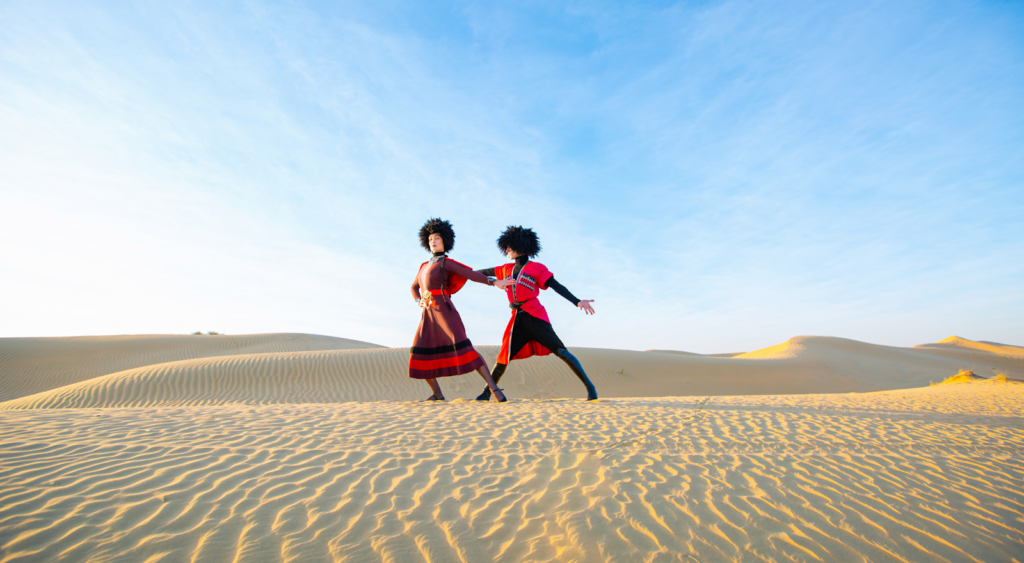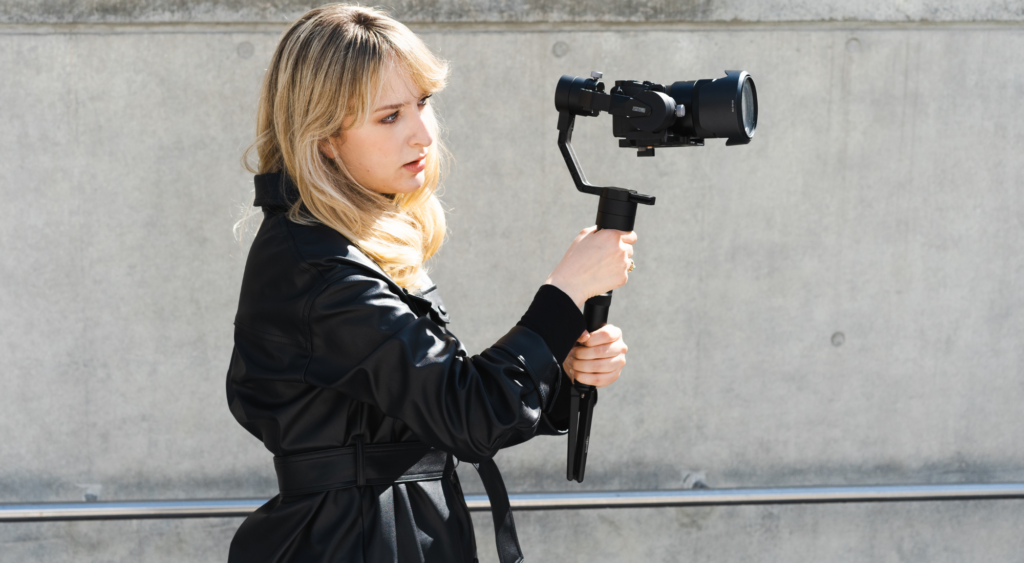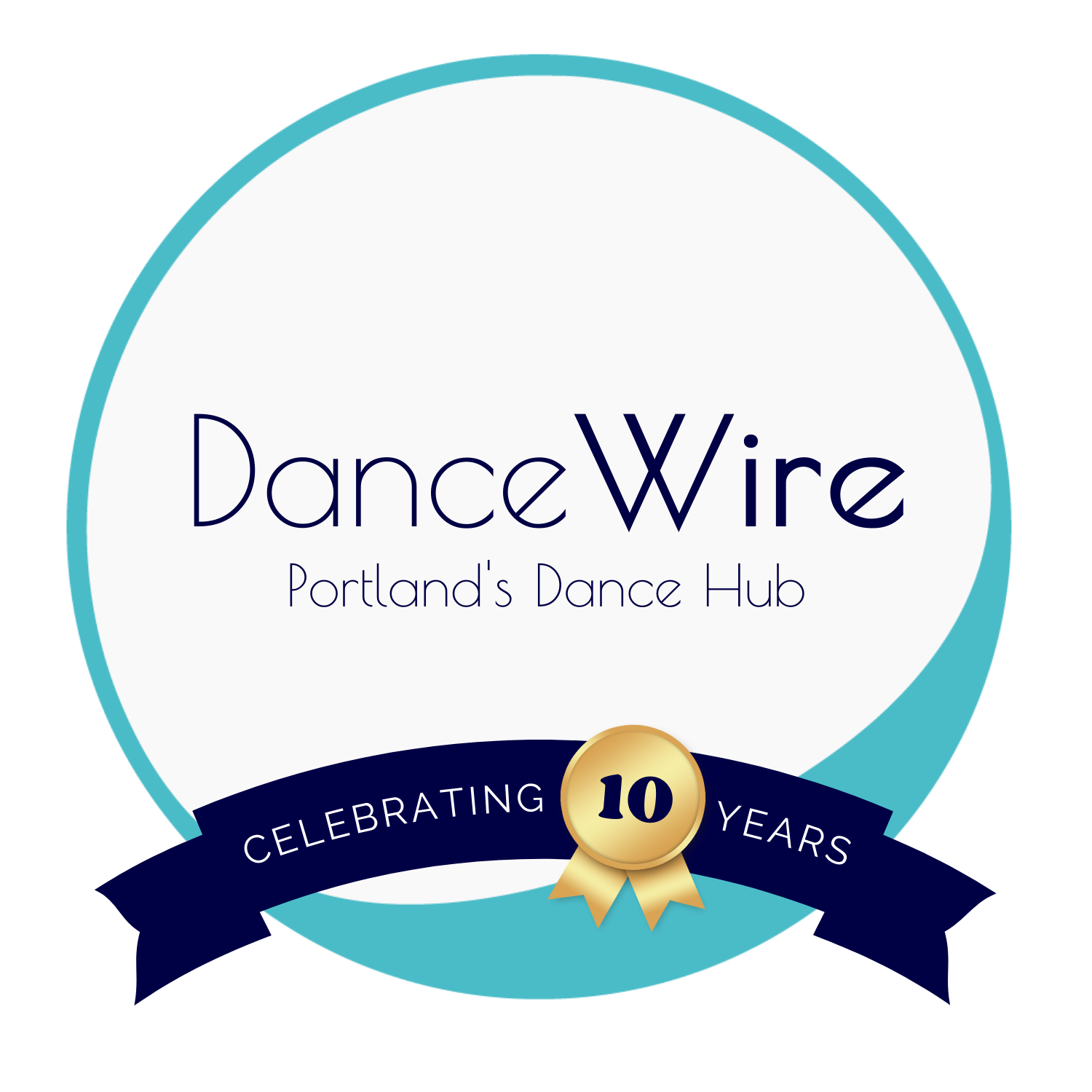Making a dance film is a fun way to bring your movement in front of a camera and have a tangible product as your result.
But making a dance film is no small feat. It often requires money, a team of professionals, and plenty of time.
Learn all about what it takes to make a dance film and what necessary resources and support you will need for a successful final product.
Table of Contents
- The Increasing Popularity of Dance Films
- Making a Dance Film vs. Producing a Live Show
- How To Go About Making a Dance Film: The Logistics
- Dance Wire: Find Resources and Support for the Making of Your Dance Film

The Increasing Popularity of Dance Films
Movement has always been a part of film. Silent films have no audible dialogue and instead tell stories visually and through movement and emotion.
Similarly, dance films – also called dance-for-film, dance-for-camera, or screen dance – use movement to tell stories that are better told through the film medium than live performance.
There are even film festivals specifically dedicated to showing dance films. Portland Dance Film Fest, for example, has been successfully sharing films from across the world with Portland audiences since 2017.
When the COVID-19 global pandemic left dancers and companies without a live audience, the popularity and visibility of dance films increased and many turned to creating dance films or live streaming as a way to keep sharing their work.
Pandemic aside, dance films have many unique elements to offer for dancers and audiences alike and will inevitably be a method of dance performance that will continue to grow and thrive.

Making a Dance Film vs. Producing a Live Show Comparison
Making a dance film and producing a live dance show have some similarities. For example, they’re both large projects that require time, money, and when done well, skilled project management.
Here are a few of the things that make each unique.
Live Show
- There’s an excitement to live performance, anything could happen!
- Requires audiences to be in the moment. (a big win in the age of distraction!)
- Energy given and received by both performers and audience.
- Audiences feel a sense of community with others at the show.
- Once the show is over, it is gone making the experience of it more magical
Film
- There are new opportunities for storytelling through the ability to choose camera angles and better control the audience’s point of view
- You can explore unique settings and places to dance in (for example: the desert or the water) where you wouldn’t otherwise be able to take dance audiences
- You can do multiple takes to get the most polished version of the performance possible
- Dance films can travel around the world without the costs of production and touring with a full cast
- Audiences can watch at their convenience and share with their friends more easily.
Creating a Dance Film Results in a Tangible ‘Product’
If you choose to create a dance film, walking away with a tangible finished product is one of the most valuable parts.
You can use this film to your advantage by:
- Building new audiences beyond those who can and would attend your live show
- Distributing it to film festivals
- Using it as a part of your portfolio to help get more work
- Using it to show a quality sample of your work for securing funding for future projects
If you’re a part of the dance community in the greater Portland area and are looking for resources, Dance Wire can help. We have many connections to …
- Performers
- Venues
- Tech people
- Photographers
- Cinematographers
Connect with us today to jump start your project!
How To Go About Making a Dance Film: The Logistics
Making a dance film isn’t simple, and everyone has their own process when it comes to producing one.
Whatever your process might be, the logistics are similar.
Outline Your Plan
You can’t just gather a group of dancers, grab a camera, and start filming.
Or maybe you can, but even a little planning will go a long way. The more you figure out in advance, the easier and cheaper your shoot day(s) and editing process will be.
Start making a plan by creating a storyboard about your project.
Your storyboard doesn’t have to be fancy. You could utilize a computer program or software (we like Canva) but, a collage, or even stick figures drawn on paper will do. A storyboard consists of photos, concepts, and ideas. It is here that you can pull everything out of your mind and get it on paper, visualize it, and consider how to make your film come to life.
Remember, dance films offer a unique ability for storytelling, so take time to consider camera angles, framing (how close or far away are you from the dancer), location etc.
As you move through the creative process, this will turn into a shot list. Developing a shot list before you shoot will help the shoot will run efficiently and ensure that you get all the shots you need – it’s very difficult and costly to go back and reshoot so preparation is key. If you are directing and performing in the film, a shot list will also give you space to focus on the performance when the day of shooting arrives.
Secure Funding
Your budget may be big or small, but you’ll likely need funds to pay for things like:
- Dancers
- Film crew (cinematographer, gaffer, grip, director)
- Producers
- Venue
- Costume/Makeup
- Catering/Food
- Editing team (editor, color correction)
To secure funding, you can:
- Apply for grants (usually very competitive)
- Use crowdfunding
- Build your audience through a platform like Patreon
Raising money is usually a long process, so don’t wait until the end to start! The earlier you begin fundraising the better.
Choose a Filmmaker, Crew, and Producer
Dance films can be made with one person and a single camera or a whole team of dancers and a fully stacked film production crew.
Who you need to create your dance film will depend on your vision.
Consider these things when choosing a filmmaker, film crew, and producer:
- What quality of work are you looking for? Something film festival ready or something to build your portfolio?
- Do you need skilled professionals ($$$) to achieve your vision or would someone interested in building their own skills do?
- Can one person handle doing the lights, being the artistic director, using the camera, designing the set, etc.? Or does this project require a team of specific professionals to get the desired outcome?
- If you want skilled professionals, do you feel confident raising the money to be able to hire them?
- If finding someone new, have you seen any of their previous work? What do you like about it and do you think they may be a good match for your project?
- Do you have any existing collaborators? Do they have contacts?
- Who else can you reach out to (hint: Dance Wire!) for help making connections?
Source Your Talent
Finding reliable dancers for your dance film is very important.
Not only do you want them to be great dancers, but you also want them to be timely, reliable, and easy to work with. Remember, making a dance film will take time and you’ll have to count on these dancers to show up consistently for filming and take direction well.
If you’re a dance company that already has core dancers, you probably won’t be looking elsewhere for talent. But if you’re an independent dancer looking to create a film, you might be wondering where to go to source your talent.
Contact us to get access to our resources within the dance community or take advantage of our 1:1 sessions if you’re looking for help with a dance project.
Choose Your Setting
The possibilities are endless when it comes to choosing a setting for your dance film. If you’ve been to dance film festivals or seen any dance films online, you’ll see that artists work within a range of settings. From an epic desert scene to a city sidewalk to an abandoned warehouse the setting is all part of the storytelling.
A few things to keep in mind:
- Will you need a permit to shoot in that location? This may depend on the size of your cast, how populated the area is, and what equipment you are using.
- If you are using a drone, your camera operator needs a special license for that and in many locations, you will need a permit to use the drone.
- Do you need to prep the area in any way before getting your whole cast and crew out there? Cleaning a dirty space, or making sure there are no safety hazards for your cast and crew.
It’s wise to know these details before getting too far into the creative process!
Rehearse
Rehearsal is an important part of the process when making a dance film. Not only will you rehearse the choreography, but for best results you will also need to rehearse with the crew!
Whether you have a single camera operator or a whole crew of people, the more all go into the official shoot knowing what they need to capture, the more smoothly the shoot day will run.
Although the editing process allows you to film out of order and piece together the perfect final piece, rehearsals help:
- The producer see how different movements look on camera
- Dancers to be comfortable with being filmed close up and adjust to the space
- All to know how the lighting is at different times of the day if filming outside
Film
As we mentioned, filming isn’t as simple as pulling out your camera, hitting record, and letting things roll the way they just might.
Filming is a long process, often capturing many more shots than necessary just for them to be picked over and edited down to create a few minutes of video.
Consider this when filming a dance film:
- Make sure you have a detailed shot list before you start shooting and that all directors, producers, and camera operators are familiar with it so you are sure to capture what you need
- When planning your schedule, account for set up time
- Also account for costume, makeup, and lighting adjustments during the shoot
- Prepare to feed dancers and provide a place for them to take breaks, including bathrooms! Shoot days can be long.
- Decide if you’re shooting in color or black and white.
- Work through shots multiple times to allow dancers and camera angles to develop with each take.
Edit
Editing could be considered the most difficult part of making a dance film. It’s one of the major steps not required when doing a live dance performance.
And although much of the creativity happens in the planning process, a lot of creativity is also necessary during the final execution — the editing process.
Because filming often happens out of order, the producer should create a thorough rundown of the entire dance to ensure it is pieced together properly throughout the editing process.
Once you have that, keep these things in mind as you edit your dance film:
- You’ll need to cut substantial footage to create your film.
- Be willing to reorder things if necessary for the final film.
- You might be surprised by what footage you use and what you throw away.
- Cut what isn’t worth keeping.
- Let the footage dictate how the film progresses.
- Don’t be so attached to movement that you can’t trim it out to make the final film more dynamic.


Dance Wire: Find Resources and Support for the Making of Your Dance Film
Making a dance film is a fun way to express your creativity, showcase your talent, and end up with a tangible final product you can utilize forever in whatever way you need.
The creative part is up to you, but Dance Wire is here to help with the rest.
In our 1:1 sessions, we will walk you through the project from start to finish. Our team of dance consultants has produced numerous dance films of our own and have developed tips, tricks, and tools that help make the logistical side more manageable so you can focus on what you do best – being creative! Contact us today to learn more and get started.

